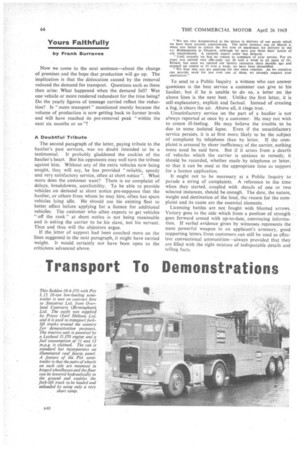Yours Faithfully
Page 66

If you've noticed an error in this article please click here to report it so we can fix it.
by Frank Burravoe
Now we come to the next sentence—about the change of premises and the hope that production will go up. The implication is that the dislocation caused by the removal reduced the demand for transport. Questions such as these then arise: What happened when the demand fell? Was one vehicle or more rendered redundant for the time being? Do the yearly figures of tonnage carried reflect the reduction? Is "more transport" mentioned merely because the volume of production is now getting back to former levels and will have reached its pre-removal peak "within the next six months or so "?
A Doubtful Tribute
The second paragraph of the letter, paying tribute to the haulier's past services, was no doubt intended to be a testimonial. It probably gladdened the cockles of the haulier's heart. But his opponents may well turn the tribute against him. Without any of the extra vehicles now being sought, they will say, he has provided "reliable, speedy and very satisfactory service, often at short notice ". What more does the customer want? There is no complaint of delays, breakdowns, unreliability. To be able to provide vehicles on demand at short notice pre-supposes that the haulier, or others from whom he may hire, often has spare vehicles lying idle. He should use his existing fleet to better effect before applying for a licence for additional vehicles. The customer who often expects to get vehicles "off the rank" at short notice is not being reasonable and is asking the carrier to be his slave, not his servant. Thus and thus will the objectors argue.
If the _letter of support had been couched more on the lines suggested in the next paragraph, it might have carried weight. It would certainly not have been open to the criticisms advanced above.
To send to a Public Inquiry a witness who can answer questions is the best service a customer can give to his haulier, but if he is unable to do so, a letter on the above lines is the next best. Unlike the first letter, it is self-explanatory, explicit and factual. Instead of creating a fog, it clears the air. Above all, it rings true. , Unsatisfactory service on the part of a haulier is not always reported at once by a customer. He may not wish to create ill-feeling. He may believe the trouble to be due to some isolated lapse. Even if the unsatisfactory service persists, it is at first more likely to be the subject of complaint by telephone than by letter. If the complaint is aroused by sheer inefficiency of the carrier, nothing more need be said here. But if it arises from a dearth of vehicles which the carrier is anxious to remedy, it should be recorded, whether made by telephone or letter, so that it can be used at the appropriate time as support for a licence application.
It ought not to be necessary at a Public Inquiry tO parade a string of complaints. A reference to the time when they started, coupled with details of one or two selected instances, should be enough. The date, the nature, weight and destination ofthe load, the reason for the complaint and, its cause are the essential elements.
Licensing battles are not fought with blunted arrows. Victory goes to the side which from a position of strength goes forward armed with up-to-date, convincing information. If verbal evidence given by witnesses represents the most powerful weapon in an applicant's armoury, good supporting letters from customers can still' be used as effective conventional ammunition—always provided that they are filled with the right mixture of indisputable details and telling facts.












































































































